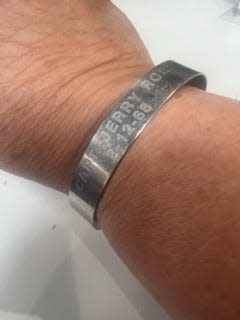He was lost in Vietnam 54 years ago. I still wear his name, even if I never met him

A lovely woman has helped me with my nail care for 15 years. She is kind and we are friends. I see her once a month.
She gently removes my wedding ring, then The Bracelet. She carefully places them in a pretty glass bowl. She is as careful with The Bracelet as she is with my wedding ring. It’s sturdy stainless steel, scratched and a little lopsided from years of wear. The wedding ring? It’s only two years old and still shiny and new.
But The Bracelet. It’s been places and done stuff. For more than 50 years, I’ve worn it. I wore it when I learned to drive my dad’s stick-shift Chevy. I wore it when I wrecked his Cougar. I wore it when I painted my dorm room. I wore it when I got married. Both times. I have given CPR while wearing it, and I have knitted a pile of scarves while wearing it. Somehow it always tangles my yarn.
I wore it as I held my daddy’s hand for the last time. And my mama’s. And my little sister’s. I wore it while I nursed my baby boy.
Once in a while, I forget about The Bracelet. It’s so much a part of me that I forget it is there.
They asked us to wear them 'till they come home'
The now-battered band of stainless steel cost me $10 bucks in 1969. All my classmates were buying them. I bought mine on a cold and rainy Saturday at the Fort Worth Fat Stock Show. Earnest, long-haired college students were there to sell us bracelets, and tell us about how important it was to wear them in support of POWs and MIAs (prisoners of war and missing in action) in Vietnam.
My friends and I dug $10 from the pockets of our bell bottoms and we made the solemn promise to wear the bracelets “‘till they come home.”
Our bracelets were shiny stainless steel then, and the black block letters engraved on them told us the name of a young American and the date he (they were all males back then) had been lost.
Mine read:
CAPT. JERRY ROE 2-12-68
At home that night, the television news showed young American soldiers fighting a war, just like we saw every night at dinner. Walter Cronkite droned on about the day’s casualties. I didn’t really realize that meant dead soldiers just a couple years older than me.
They never came home. Families never got answers
My dad asked me about The Bracelet. I did my best to explain what it meant. I told him about my promise. He looked at my mom and neither of them said anything.
Did any of us high school students understand what our shiny new bracelets really meant? I didn’t. But now, more than 50 years later, I think I do.
Mine meant that a young wife in Texas was left with a hole in her life. Was she a widow? She didn’t know. She hoped he would come home. As did his mom and dad.
Jerry had been born into a close-knit family on March 16, 1943 – during a world war – in a safe little town called New Boston, Texas. He left for Vietnam after college, and flew helicopters for the Army.
On Feb. 12, 1968, Jerry, his crew and the helicopter they were aboard disappeared in the jungles of Vietnam.
Every day, those who loved him wondered what had happened to Jerry and his three crewmen, all young U.S. soldiers: Wade L. Groth, Alan W. Gunn and Harry W. Brown.
Jerry’s parents, his beloved cousin Sandy and many others have died, waiting faithfully and without answers. The families of Groth, Gunn and Brown have never gotten clear answers, either. That happens in war.
The Bracelet wasn't enough, so I did more. We all can
Jerry’s family knew the U.S. Army helicopter he piloted had disappeared from the radar screen of his home base about 20 minutes after departure. They were on an urgent medical evacuation mission. Jerry’s family knew there had been an intensive three-day search, per Army protocol, then all four crew members had been declared missing.
In the years that followed, U.S. military members searched for signs of the helicopter and crew. Nothing.
Much later, there were reported sightings and other evidence that some of the crew were alive and imprisoned in Vietnam. But nothing about Jerry Roe, the kid from New Boston, Texas.
I remember feeling guilty as I went to college, because I was a girl, being unconcerned with being drafted to go to Vietnam. So I did what I could, which had a pathetically low impact on my life. I kept wearing The Bracelet.
I started donating blood through the American Red Cross. I started volunteering with the American Red Cross. I read books about how the American Red Cross had been founded during war, and was still serving during blue skies and gray skies. That was during the ‘70s and friends and family went to Vietnam. All came home safe, physically.
Fast-forward to Memorial Day 2022. Captain Roe is still not home. He’d be almost 80 now. I’m nearing 69. I’m still giving blood. I’m still volunteering with the American Red Cross. And I’m still wearing The Bracelet.
Trudy Thompson Shumaker served as communications director for the Arizona-New Mexico-El Paso Region of The American Red Cross, and has been a volunteer the last 10 years as a disaster nurse, assisting those affected by house fires, hurricanes, mass casualties and wildfires. Reach her at tthompsonrice@gmail.com.
This article originally appeared on Arizona Republic: Why I still wear the name of an MIA soldier I never met
